Customer testimonials are one of the most powerful ways to convert prospective customers into buyers. In this guide, we’re going to dig deep into exactly how to collect, create, and use real customer stories to drive business results.
We’ve organized this guide around the following topics, so feel free to jump around to any section that immediately interests you:
As you can see, we’ve included a section specifically about the benefits of testimonial videos and how to use our own platform, Vocal Video, to record and collect them easily (skip to that section here) whenever your marketing strategy requires it.
We set up Vocal Video to give brands, big and small, access to an affordable and scalable platform to collect high quality video testimonials directly from satisfied customers — without the hassle and expense of professional video production.
If you want to try using Vocal Video to collect, edit, and publish customer testimonial videos, you can sign up for a free Vocal Video account.
The Power of Testimonials
Testimonials work. But don’t take our word for it. Groove reported a 15% conversion lift from using testimonials in email, on its home page, and landing pages.
In this section, we'll lay the foundation for why customer testimonials should be at the heart of your marketing efforts.
Growth marketers report that social proof, like testimonials, consistently yield the best results over other strategies in their experiments. 89% of marketers rate testimonials as the most effective type of content marketing that they do.
Plus, 90% of buyers report that reading positive reviews and testimonials influence their purchase; the presence of 50 or more reviews or testimonials on a site can boost conversion by 4.6% or more.
In fact, 95% of medium-sized organizations realize 10+% improvements in conversion on campaigns that use video testimonials compared to those that don’t. Testimonials mean more dollars in your pocket.
As marketers, customer testimonials do two things for us:
- Convert more traffic and leads.
- Act as an evergreen content supply that attracts more interested, qualified buyers to your site while building trust with your brand.
A double win.
Try Vocal Video free — no credit card required — and get started easily collecting, editing, and publishing customer testimonial videos and video reviews.
Why Testimonials Convert More Buyers
How exactly do customer testimonials boost conversion?
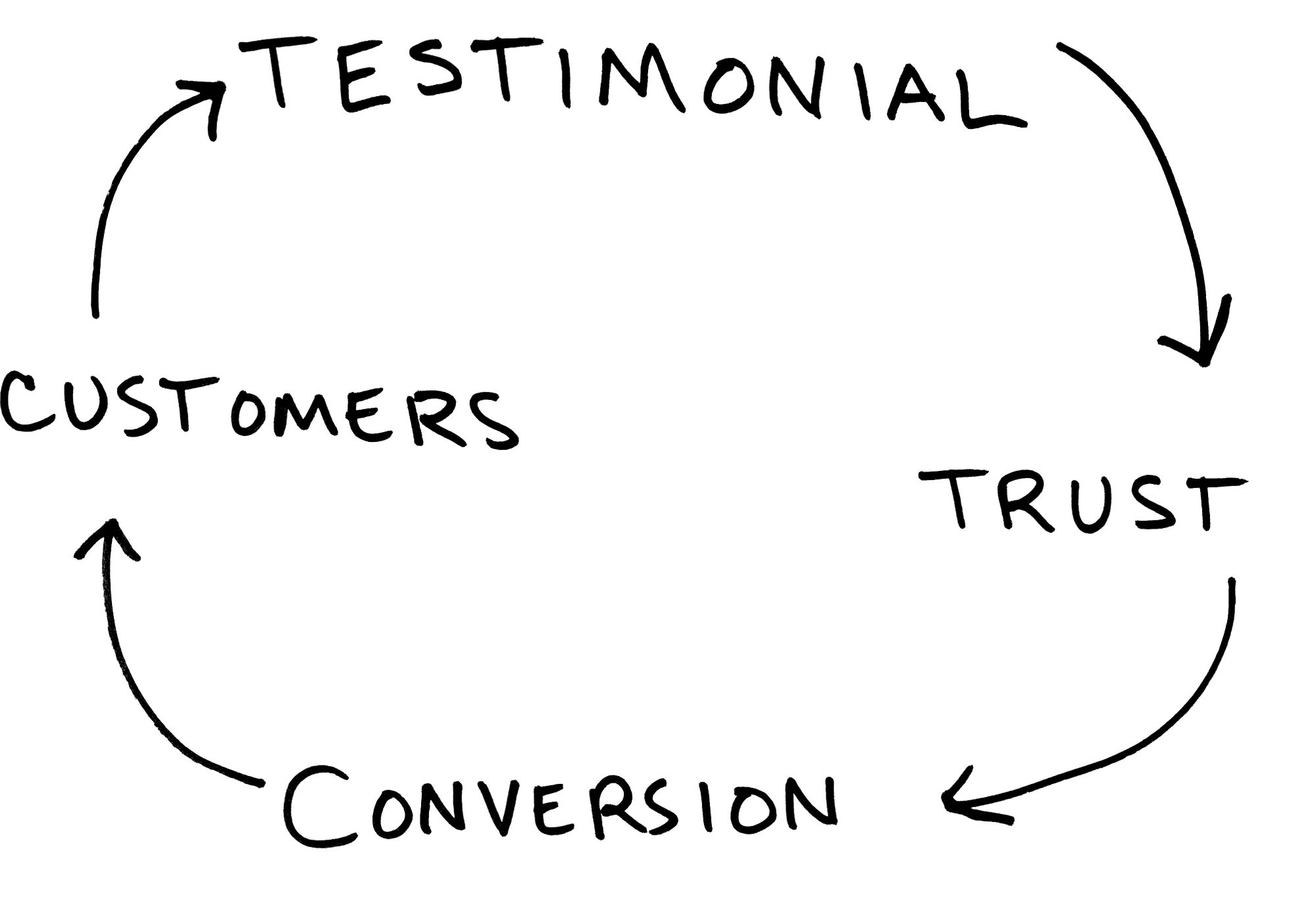
Testimonials can create a true virtuous cycle. A prospective buyer visits your site. They read, watch, or listen to your testimonials, which might appear on the home page, campaign landing page, checkout page or in a customer gallery. They identify with the customer who is talking, the problem solved or the benefits received.
This identification with your customers builds trust in your company and product/service, and removes the friction in their journey to the next step in the buyer’s journey.
Relatable customer stories also de-risk your prospect’s purchase. They know that they are not the first person to buy the product or service to solve their problem. Since they trust your company and know other people like them use your offerings, they are more willing to provide their contact information or sign up for your service. These visitors convert at a higher rate to a lead or a sale than if there was an absence of testimonials and social proof.
The result: You get more customers, who in turn give you more testimonials, and further raises your ability to convert future customers with your arsenal of testimonials. A virtuous, positive feedback loop is born.
Objectives: Use testimonials on website to de-risk purchase decisions and lead capture.
Key Results: Friction is removed from the buyer’s journey by building trust with your buyers, thus improving conversions.
Testimonials Attract More Leads
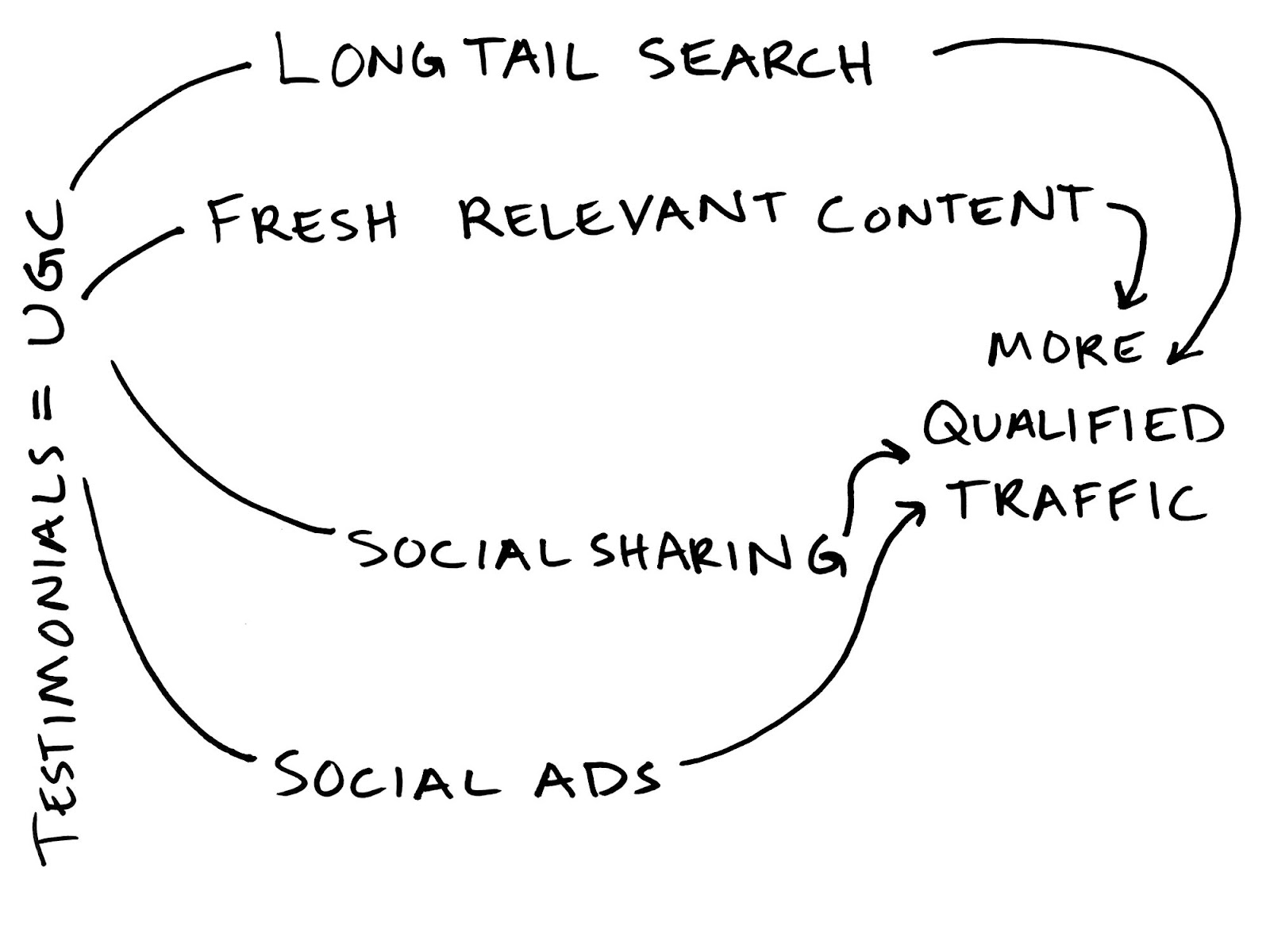
We’ve now covered why testimonials are so powerful, and how they are able to convert at higher rates than other marketing strategies. But the benefits don’t end there. Building a collection of testimonials and reviews across industries served, use cases and company size pays dividends for attracting new prospects.
First, large numbers of reviews and testimonials represent a treasure trove of User Generated Content (UGC). This kind of content is chock full of long tail keywords that your buyers use to search every day. Essentially, it is a crowdsourced collection of all the words and phrases that your buyers use to describe what they are looking for in your product or service.
Sites that employ lots of user generated content see increased organic search traffic. This traffic is hyper targeted to use cases relevant to your product and service and typically converts at much higher rates than other traffic sources and marketing channels. By continuing to collect and showcase new testimonials, your site will be constantly refreshed with fresh content, another boon for SEO.
Finally, testimonials make compelling social posts. Social posts and ads on Facebook, Twitter, Instagram, and LinkedIn that feature customers enjoy higher CTRs and more reach. In fact, research done by Yotpo indicates a 300% improvement in CTR.
Customer testimonials generate more engagement than typical marketing topics, plus they also build trust. As Zuckerberg said: “People influence people.” And Facebook may be the greatest example and experiment in how referrals work at a truly global scale.

Higher CTRs and greater reach ultimately means more traffic from social channels. Of course, you should always do everything you can to capture those leads once they're on your page with things like an exit intent message.
As a result, testimonials and reviews should play a central role in your social media marketing and advertising efforts, along with increasing your SEO reach.
Objectives:
- Generously embed testimonials on your website.
- Set up a system to consistently add new testimonials to your website.
- Use customer testimonials as compelling social media posts and ads.
Key Results:
- More long tail keywords improve SEO (search engine optimization).
- Fresh, relevant user generated content improves SEO.
- Higher click through rate on social posts.
- More qualified traffic to your site.
Social Proof: The Science Behind It
Customer testimonials are a form of social proof. Social proof is a long documented psychological concept based on studies and observations that show humans are strongly inclined to follow the actions of a group.
You may have heard of Robert Cialdini’s work on social proof covered in his classic book, “Influence” or experienced it first hand as you browse Yelp reviews to figure out where to eat dinner.
Social proof becomes particularly powerful when faced with uncertainty — which is where we start most purchase decisions. By seeing credible evidence of the correct behavior (like testimonials from people like us who made the right decision) we can get to what feels like the right decision, faster.
Try Vocal Video free — no credit card required — and get started easily collecting, editing, and publishing customer testimonial videos and video reviews.
Who to Ask for a Testimonial
Let's assume you're convinced about the power of testimonials and exactly what they are. Once you’ve committed yourself to placing your customers front and center in your marketing and leveraging the power of testimonials, it’s time to execute on your strategy. The questions become: Who do I ask? Will they do it? What will they say? Will they be credible? All valid questions.
Recall that the most important thing is that buyers need to see themselves in the testimonials. They want to identify with the testimonial subject. In B2B, either they are from the same industry or a similar position or role at a company. Or they might have the same problem or challenge that the subject describes. In B2C, they want to see consumers who share demographic traits or who they connect with emotionally. That perceived connection is what taps into the psychological power of social proof.
Check out real testimonial video examples from Google, Comscore, and Martha Stoumen Wines.
Satisfied Customers Make Great Testimonials
Authenticity and credibility are important, but with that said your primary target of testimonials should always be your satisfied customers. You want to think about how to identify customers who are happy, if not passionate, raving fans and ignore the neutral to upset customers in your base. Both satisfied customers and raving fans are good targets, although you may need to leverage more social capital to get the purely satisfied customers on the record.
5 Key Factors to Consider Before Asking for a Testimonial
You’ll need to weigh a couple of factors to select your best testimonial prospects. There aren't any right and wrong answers here. Ultimately, you’ll be amassing lots of testimonials and each will have a role or purpose in reinforcing your marketing messages. As a result, you’ll want diversity across all 5 factors.
Here are some factors to consider before you target subjects for testimonials:
1. Authority Level: A classic conundrum is whether to ask the most authoritative person for your testimonials or someone who knows your product or service the best. This usually breaks down into the questions: should I get an executive of the company? Or find a user to vouch for my product or service?
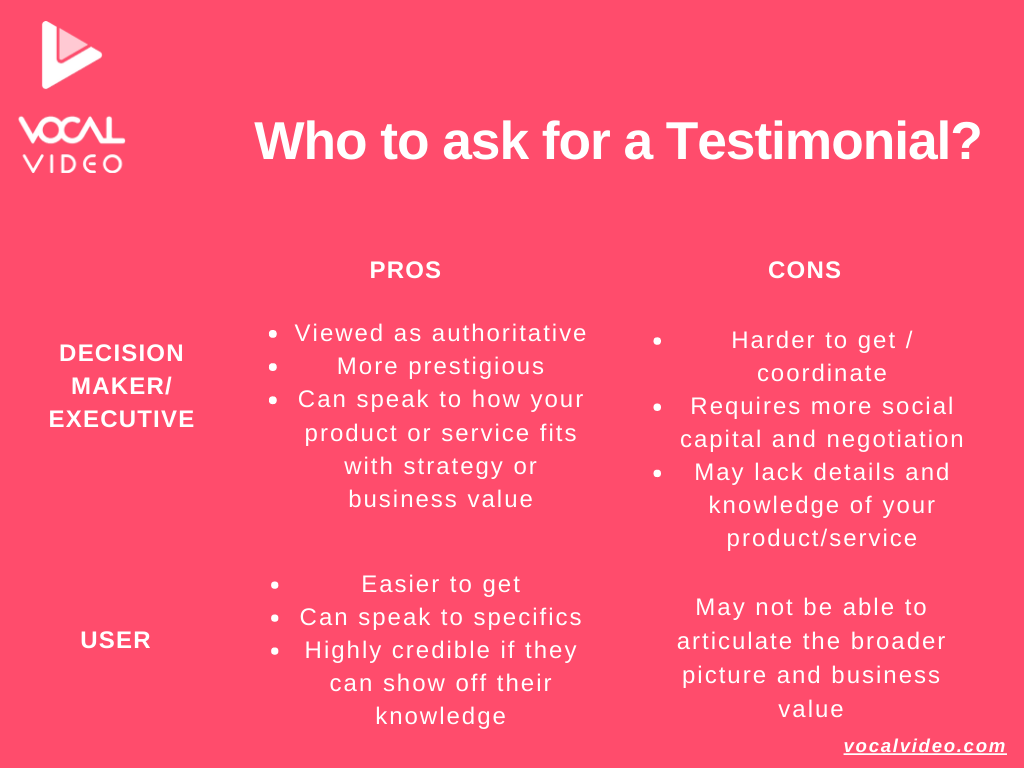
Pro tip: We recommend both.
Focus on a couple of executives who know your product or service well and can be strong advocates. They will likely require more time to get the testimonial. However, don’t ignore users. Reach out your most ardent, passionate fans and build out all the different combinations of message, role, department, etc that you will want for a diverse set of testimonials.
2. Department (Sales vs. Marketing vs. Finance vs. Manufacturing): If your product is only purchased and used by one department, then you should focus on getting testimonials from different roles within that department (e.g. demand generation, social media manager, and content marketer for the marketing department). Alternatively, in more complex cross-function purchase decisions, it is important to get testimonials from different departments (e.g marketing, sales, finance, etc). Each different department testimonials can be used to attest to a different aspect of the value proposition. This kind of department diversity is crucial in classic B2B purchase decisions where multiple stakeholders are involved in decision making.
3. Industry Segmentation: You ideally want several testimonials from each industry or type of business that you sell to. These industry proof points give your knowledge credentials in that domain and de-risk the decision for each customer in a particular industry. Prospective buyers always believe that their industry or situation is completely different from other industries and customer scenarios. The easiest way to overcome that objection is with social proof of success in the particular industry or market segment.
4. Knowledge of Product and Specific Situational Details: The ideal testimonial subject is knowledgeable about your product or service, not just a talking head from the company. A testimonial subject who cites specific details about their usage or implementation of the product or service is far more credible than a generic sweeping statement about how great the product is. Encourage your testimonials to be specific and give details wherever possible.
5. Alignment with your Marketing Message: Before you ask a testimonial subject, you want to be reasonably sure that what they are going to say aligns to your overall marketing messages and positioning. For example, if you are positioned as the luxury, high cost brand, a testimonial that says that they purchased you because you were the cheapest is of no value to you. Ideally, you want to be sure that the subject can speak to one or more key value points that you want to emphasize in your marketing.
After digesting those factors and adding up the combinations, it can be quite intimidating. But the best advice is to play the long game. Find a couple advocates that meet your criteria, get them on the record, and then continue to build out brick by brick from there. You’ll be surprised how much progress can be made if you put sustained effort into a testimonial collection program.
Pro tip: Consider automating the process so it just happens without any intervention from you.
Objectives:
- Identify customers and customer stories that will resonate with your buyers and are credible.
- Write a list or content matrix with the different personas or use cases that you target for your product or service. Target testimonials that speak to each of those use cases.
- Prep your customer with good questions that will help them speak to your particular marketing message and with specificity to your product or service.
Key results:
- A wide and deep collection of testimonials that will resonate with the diversity of buyers in your target market and build great trust with your brand.
- Friction is removed from your buyer’s journey.
Industry Expert Testimonials
Although satisfied customers are the bread and butter focus for testimonials, you should also consider a second constituency — industry experts — for your testimonials. The types of industry experts vary by domain, but can be categorized into four different types:
- Subject Matter Experts: These are authority figures who are very familiar or knowledgeable in the domain you serve. For example, this could be a college professor steeped in a key academic area relevant to your product or service. Or it could be a security professional who can speak to the challenges and intricacies of key security vulnerabilities. Ideally, these subject matter experts should be credible with your buying audience, but it is not crucial that they have a large social following or even be particularly well known outside their area of expertise.
- Industry Analysts: Industry analysts perform primary and secondary market research on a particular industry or domain. Example firms include, Gartner, Forrester, IDC, but there are many small boutique firms and the firms vary widely by industry. Analysts are experts in a specific market and they dialog with the buyers in that industry to understand the market trends along with the vendors that serve that space. As a result, they can be great resources on the competitive landscape and future direction of the market. Although they often will not endorse or speak about a particular product or service directly, they have a unique and invaluable perspective to share on the direction of the market and what are important buying criteria.
- Bloggers: Undoubtedly there are at least several blogs that speak to your target market. These bloggers have already done the hard work of growing significant followings and may have significant mindshare with your target customers. Unlike industry analysts, bloggers may be more than willing to give you a testimonial and may in fact be willing to endorse your product or service. They can be an excellent source of third party testimonials.
- Partners: Your company may have partnerships with other companies that you collaborate on selling and providing a solution to the end buyer together. These types of partners are excellent sources of testimonials, particularly partners with more brand recognition and credibility than your company. For example, if you are a small startup, a testimonial from Microsoft could be marketing gold. These partners can speak to the efficacy of your product or how your product works with their solution. These types of testimonials de-risk a purchase and can lend an aura of success, particularly if the buyer already trusts or uses the partner’s product or service extensively.
- Resellers and Consultants: Last, but not least. Your product may be resold or implemented onsite by a third party firm. These consultants and resellers have direct knowledge and relationships with the buyers. Although the buyer might be the ideal testimonial target, resellers and consultants can be excellent targets as well, since they have direct knowledge of the buyer’s organization, the problems they faced, and the business results that they achieved. And thus, they can be a great replacement or complement to end buyer or user testimonials.
Industry experts will not usually have hands-on experience with your product, nor have they purchased your product or service. The one exception to this rule is reseller and consultants who may have had experience implementing your product on behalf of a customer. Thus, most of them can’t speak to real-world experiences, performance, quality, and value of your offering like a customer can. As a result, the type and nature of their testimonials are different.
Nonetheless, content from industry experts can be particularly compelling and useful at generating awareness in three specific scenarios.
- First, they can speak and describe the type of problem you purport to solve in detail and provide context to why it is important to solve it. For example, an industry expert can add credibility to the problem by citing their first hand experience trying to solve it, the research that they have conducted, or their own knowledge of the domain and industry. An unaffiliated third party should not, nor do they need to, endorse your product or service to be effective. Nor should you ask them to do it. That is the role of your customers.
- Second, industry experts can be used to create urgency for the need to fix a problem. They can remind buyers of the risks that can come about from not taking action quickly. For example, a security professional might speak to the consequences for not taking action or the results of not protecting against malware or other attacks.
- Third, industry experts can be articulate spokesmen for market and industry trends. They can give their unique perspective on the market, where it is headed, and provide a broader context than a single vendor or company can provide.
Objectives:
- Consider the universe of industry experts that are available to you and identify which ones may be beneficial to partner with
Key results:
- Increased awareness of the challenge that your product or service may solve, increased urgency for your buyers and the potential for these experts to shed a light of credibility on your brand.
Try Vocal Video free — no credit card required — and get started easily collecting, editing, and publishing customer testimonial videos and video reviews.
How to Overcome Top Challenges in Getting Compelling Testimonials
For most of this guide, we’ve operated under the principle: “ask and you shall receive.” However, it doesn’t always work that way when soliciting testimonials. Just because you approach a happy, engaged customer for a testimonial, you are not guaranteed that they will want or even be able to participate. So let’s talk about what are the key obstacles for successfully getting testimonials and how you can overcome some of these objections.
Objections for testimonials break down into two categories: hard objections (legal and policy related) and soft objections (more vanity and time oriented). In general, it is much easier to overcome the soft objections with persistence and accommodation than it is to overcome the hard objections. It's useful to mention that objections can also come from within your organization, from legal teams or customer-facing teams like sales. Our approach to video releases for testimonials can help.
Check out real testimonial video examples from Google, Comscore, and Martha Stoumen Wines.
Hard Objections to Testimonial Requests
Good news, bad news. If you’re a B2C marketer, you most likely will be able to avoid most hard objections since you’re dealing with individual consumers, not large companies. However, if you’re a B2B marketer, then you will almost certainly encounter hard objections to your testimonial requests. Specifically, the larger the company where the testimonial subject works, the more likely you will encounter hard objections.
A hard objection is when either industry or company policy prohibits or severely restricts a satisfied customer to provide an on the record testimonial. The customer may be a raving fan, but they need approval from an executive, their legal department, Public Relations (PR) department, or all three. This set of approvals adds a new set of hurdles to getting customers to speak on the record.
Obstacle #1: No Endorsement Policies
Some companies have explicit corporate policies that prevent customers from naming and publicly endorsing vendors and their usage of a particular product or service. Customers can often get exceptions to these policies, but they require an intense back and forth negotiation with multiple stakeholders that don’t have much incentive to help you.
To get a testimonial approved at a large company with a no endorsement policy, you must first identify a willing subject and they must in turn get permission from their boss or line of business executive (usually VP level), plus they will often times need to run the testimonial content by their legal and PR teams. Each of these teams will review it on the basis of different criteria.
The legal team will want to ensure that the testimonial is completely factual and does not expose the corporation to any risk or false statements. As a result, they will be very cautious in what can and cannot be stated in the testimonial. It is not uncommon that a glowing authentic testimonial will be edited or severely watered down so that the strong assertions or quantified benefits are dramatically weakened. This is one of the reasons why when you see testimonials from large companies they often aren’t impactful or sound anything like an actual human might say. They say almost nothing at all! What a complete and utter waste.
PR teams will often want to review testimonials as well. PR will review testimonials for whether the message is on brand and places the company in a positive light. Their brand promise and goals will be different from yours. PR may ask the question why should our big brand be associated with your small brand? How does that help us?
You can get testimonials approved by these stakeholders, but be prepared to negotiate on content and also be professional, yet persistent in pushing them through these approval processes. Also, you should expect that these approval processes will add weeks if not months to the overall timeline before you can use a testimonial in your marketing.
Obstacle #2: Privacy and Regulatory Policies
The regulatory and privacy environment that many firms operate within can be another impediment to getting a testimonial. Specifically, financial services and healthcare firms are particularly bound by stringent regulatory regimes.
In healthcare, marketers must ensure that the testimonials do not reveal any protected health information about a patient and any featured patient must complete an authorization release. Furthermore, the FDA has cracked down on patient testimonials and made sure that their contents and claims are totally consistent with the clinical trials and don’t go beyond those claims.
In the financial services industry, the SEC prohibits the use of client testimonials for financial advisors. As a result of the Investments Advisers Act of 1940 (206(4)-1(a)(1)), financial advisors cannot use testimonials concerning the investment advisor or concerning any advice, analysis, report or other service rendered by an investment advisor. However, other areas of the financial services industry don’t face these restrictions.
Strategies for Overcoming Hard Objections
Hard objections represent the biggest impediment to collecting high impact testimonials. Your success in getting larger companies, particularly in heavily regulated industries, to participate and approve testimonials depends directly on how much social capital and goodwill you can develop with the customer and the organization in general. If you can get your customer to go to bat with the powers that be and particularly curry favor with a high level executive, then you greatly improve your odds of getting approval. Remember when dealing with a larger organization, expect and prepare for a lengthy negotiation and be professional, yet persistent in moving the request through the various approvals.
Above and beyond building social capital with your customers, there are two other strategies that you can employ to avoid the hard objections to your testimonial requests.
Strategy #1: Pre-Negotiated Marketing Approvals
In B2B sales deals, you can either insert language into your sales contracts that the customer agrees to do a testimonial. Ideally, you want to be as specific as possible as to what activities and types of testimonials you expect from them. Tying a testimonial request to the sale brings the issue of references and approvals to the forefront and can prevent the customer from saying “no” for policy reasons at a later date. At the negotiation phase, you have the most leverage particularly if it is a large, strategic deal for the customer. However, there is a downside to this strategy. It adds yet another friction point that must be negotiated. Often, sales people won’t push for this type of language, since they would rather close the deal and get the commission, than push hard for the customer marketing provision.
Strategy #2: Anonymous or Blinded Attribution
Another option for large customers who won’t go on the record is to obscure their personal identity or obfuscate the name of their firm.
For example, you can refer to a customer by their title or just their first name and last initial to obscure their identity (e.g. Director of IT Infrastructure or Mary S.). Likewise, you can refer to their company by their industry and size of organization (e.g. Ford Motor becomes a “Fortune 500 Automotive Manufacturer”). There are clear drawbacks to this approach since it lessens the impact and authenticity of the testimonial. However, it is often the only way to get high impact testimonials approved at large organizations.
We discuss this topic in greater depth in the How to Attribute Your Testimonials section below.
Soft Objections to Testimonial Requests
In addition to the hard objections that we just discussed, there are a number of soft objections to providing a testimonial that you may encounter. A soft objection is when the subject is either non-committal or repeatedly delays providing a testimonial. There are three main reasons for a subject to delay or decline.
Objection #1: Busy/ Inconvenient
Testimonial candidates are preoccupied with their work and their life and providing a testimonial is not high on their priority list. You can mitigate this objection by being considerate of their time and doing all the legwork to ensure providing a testimonial is as simple as possible.
What to Do: You can draft the testimonial for them and then have them approve or edit it via email. For a video, you can provide the questions and potential talking points in advance and ensure that you schedule the video shoot at a time of maximum convenience for them. Our video testimonial templates can help.
Typically, you can overcome this objection by being patient, persistent, and making the process as smooth and painless as possible.
Objection #2: Camera Shy
Some customers will seek out the limelight, while others prefer a low profile. 75% of the population suffers from the fear of public speaking. These fears can be overcome, but it takes understanding and coaching to build the subject’s confidence. Some testimonial subjects are comfortable speaking on camera as part of their job, but others are unfamiliar or afraid to do it.
What to Do: Be reassuring. Coach the customer on what makes an effective video testimonial. Emphasize that you care more about authenticity than polished speaking.
The more that you can create talking points and encourage them, the easier it is to build their confidence and overcome their fear of being on camera. Examples of other authentic customer video testimonials can also help make your customers more comfortable with clear expectations.
Objection #3: Not a Raving Fan
Some customers may be satisfied customers, but not advocates of your brand. The Net Promoter System (NPS) refers to people who give 7 or 8 (a high score on a 10 point scale) on a NPS survey as neutral. They are neither promoters nor detractors. When engaging a customer who is satisfied, but not a true advocate, it may feel like you’re rolling a boulder up a hill to get a quality testimonial. It is better to put the time in upfront determining whether they are a true advocate than it is spent trying to lead a reluctant satisfied customer to provide a strong testimonial
What to Do: Be direct with your customer and what you want from them. Ask them whether they would be comfortable providing a testimonial, but give them ample opportunity to decline your offer and still feel ok about themselves and preserve the customer relationship.
For example, you could say: “Some of our most passionate customers provide us a testimonial or agree to be filmed for a video. We recognize that this is a huge commitment, but are indebted to those who agree to do it. Does this sound like something you would be willing to do? It is ok if it doesn’t make sense at present. We’ll still be friends regardless. :-)” An offer like this gives them an opportunity to decline and preserves the existing customer relationship regardless of their decision.
How to Attribute Your Testimonials
Once you’ve gotten that killer testimonial, you will need to determine how best to cite the customer. The citation depends on a number of factors. In B2C markets, citing the name of the customer with or without some relevant demographic or psychographic information may be sufficient. Examples include:
- Joe J.
- Anja, California resident
- Guadalupe Gomez, Mom of an 8 year old boy
- Tim Nichols, Video Gamer
In B2B marketing, you typically cite customers with their name, professional role or title, industry, and organization affiliation. Examples include:
- VP of DevOps at Fortune 500 Financial Services Company
- Bob, Healthcare Operations
- Manjit Singh, Director of IT, Acme Systems
- Lauren Lockwood, Chief Marketing Officer at Green Apple, Inc.
Ideally, you would want a fully named testimonial with a video of the customer speaking on the record. That is the dream! However, it isn’t always the reality. Customers may demur or their organizations won’t approve the request. As a result, you may be forced to choose between various levels of anonymity.
Here are the different citation options and their relative pros and cons:
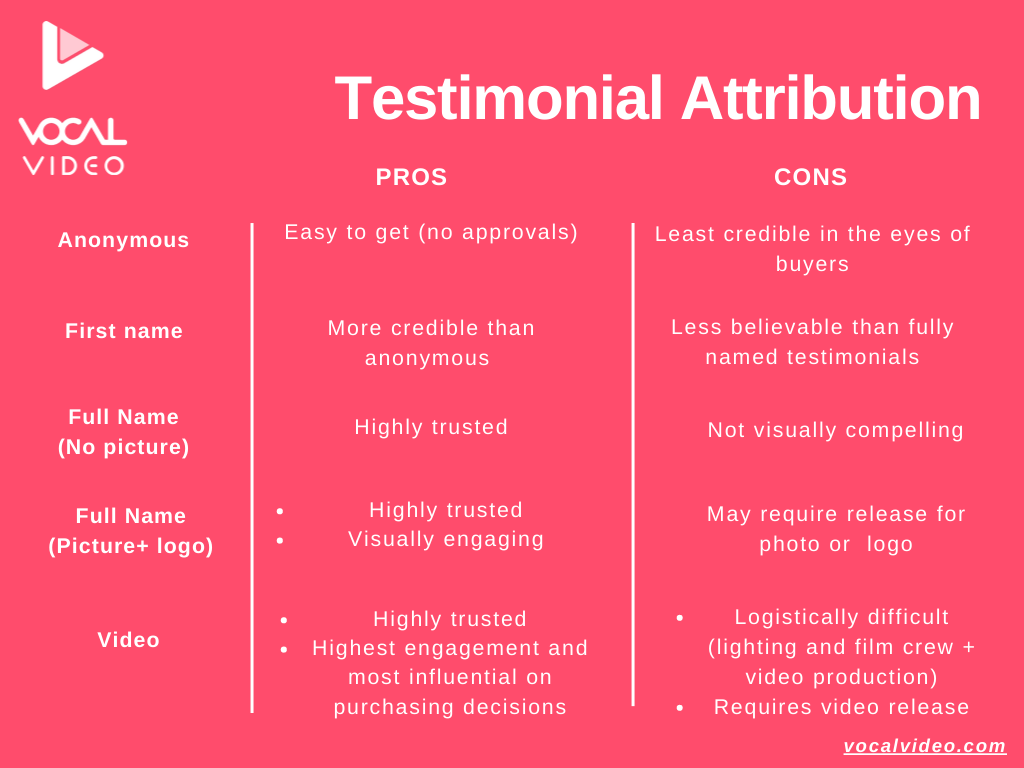
Three Legal Tips When Obtaining Testimonial Approval
There are some legal rules of thumb to consider when seeking approval for a testimonial. Consult your corporate counsel if you are unsure about the process, since different companies approach this topic differently.
In the case of testimonials, copyright, trademark, and privacy laws all come into play. In the US, copyright law states that anyone who contributes content and ideas like customer reviews and testimonials owns the underlying material. Privacy laws require consent to use other people’s identity and images in footage or photographs. Meanwhile, trademark law governs the use of corporate logos and registered marks.
Thus, a testimonial, whether it is written or a video, typically includes a customer’s logo (a corporate trademark), the name, picture or video recording of the testimonial subject (protected under privacy laws), and their user generated content (e.g. the written or video testimonial or review submission protected under copyright laws). Given that you want free rights to use the testimonial however you see fit in your marketing, you will need to obtain broad waivers from the owner (e.g. testimonial subject) to reproduce, modify, and distribute it (e.g. post on your site and share on the Internet).
Many companies and websites comply with these laws by obtaining a signed release so that they can in turn share, distribute, and modify testimonials as they choose.
You should always ensure that you have the appropriate rights to use a testimonial, before leveraging it in your marketing campaign. Otherwise, you risk having to remove the testimonial from your website and marketing materials at a later date or worse.
Tip #1: Obtain Written Approval from Your Customers
You should always get a customer’s approval before using their likeness and their words in your marketing. Luckily, this doesn’t need to be a major undertaking. A simple email from the customer approving the request should suffice and no legal documents or signatures need to be traded. The approval should always be written and not just verbal. If you get a verbal ok, then you should follow up with a written email confirming the verbal approval and to document it.
There are three common scenarios that you may run into when seeking written approval. First, you have identified a happy customer and are drafting a testimonial on behalf of the customer. This is the easiest scenario. Save the email chain and keep a central folder of all approvals that you receive.
Second, you come across an audio or video recording, a social media post, or witness a customer speaking at an event and you want to excerpt a quote and attribute it to them. In this scenario, you should reach out to the customer via email, state the source and context of the quote, and get their permission to use it. Make sure to save this email exchange for documentation purposes as well.
Third, if you are collecting the testimonials through a website, form, or other online means, you should ensure that there is language that asserts that you have the rights to use the user generated content submitted. For example, it is common to see language like this in the user agreement or on the page where the submission occurs:
“by posting or submitting content on our site, you grant the company a non-exclusive, worldwide, perpetual, irrevocable, unrestricted, royalty-free, fully paid-up, transferable license, with the right to sublicense (through multiple tiers), to use, copy, publicly perform, digitally perform, publicly display and distribute (through multiple tiers) such contributed content, and to sell, modify, create derivative works from and/or to incorporate such contributed content into other works in any form, medium or technology, whether now known or hereafter developed, in each case, for any purpose whatsoever, commercial or otherwise, without compensation to you. You agree to waive any moral rights that you may have to your contributed content.”
This kind of legalese grants you the ability to use, reproduce, and modify anything a customer submits. You can also create subsequent versions, for any reason – and not pay money for the content’s use. In this case, the act of submitting content represents a tacit approval and you do not need additional written or email documentation.
Tip #2: Get a Release for Video and Photo Use
Things get a tad more complicated when you want to make a video testimonial. Privacy laws require an individual to give consent before their likeness can be used as a photo or in footage. In this case, a simple email approval does not suffice. Before filming a customer, you must get a signed video release whereby the customer gives you written permission and agrees to waive any compensation.
In the case of Vocal Video, a testimonial subject grants Vocal and its customers a video release as part of the submission process. By contributing video to Vocal, the testimonial subject is in effect submitting user generated content and its submission is a tacit video release in of itself. Read more about our video testimonial releases here.
Tip #3: Don't Lift Testimonials from Review Websites
Review sites like Yelp, Zillow, G2 Crowd, Capterra, TripAdvisor, and many others can be a goldmine of customer testimonials. If you see a good testimonial, don’t just copy and paste it onto your own website. That is a recipe for disaster since you don’t have rights to the content.
Per US copyright law, user generated content is the property of the person who contributed the content (e.g. wrote the review). However, according to the US Small Business Administration, most review sites have terms in their user agreements that give them exclusive access and distribution rights to the contributed content. In this case, you must obtain written approval from the review site and that requires dealing with a large company’s legal department. No fun!
If you are successful in obtaining permission, the review site usually imposes restrictions in how you can use or display the content. They almost certainly will have citation guidelines and require a link back to the original content. To preserve maximum flexibility, the ideal situation is to ask customers directly for a testimonial. That way you have the rights to use the testimonials in any way possible.
We've written the ultimate guide to leveraging customer testimonials - check it out in The Definitive Guide to Testimonials.
Ready to start easily collecting, editing, and publishing customer testimonial videos and video reviews? Give Vocal Video a free try — no credit card required — by signing up here.
The Benefits of Video Testimonials
Testimonial videos can be particularly powerful compared with other static formats, like quotes or case studies, because prospective customers get to see and hear your satisfied customers talking about their experience of your brand. Seeing a real person on screen tends to be perceived as more authentic and believable than other forms of testimonials, like simple written quotes, which can more easily be made up.
Similarly to old-fashioned word-of-mouth, video testimonials give your brand more instant credibility and higher conversion rates, because putting a face to a name makes the review feel more authentic. In fact, a Vocal Video survey of 456 marketing professionals found that 88% of marketing teams saw a +10% increase in conversions when they used testimonial videos, and almost half saw an increase of +25%.
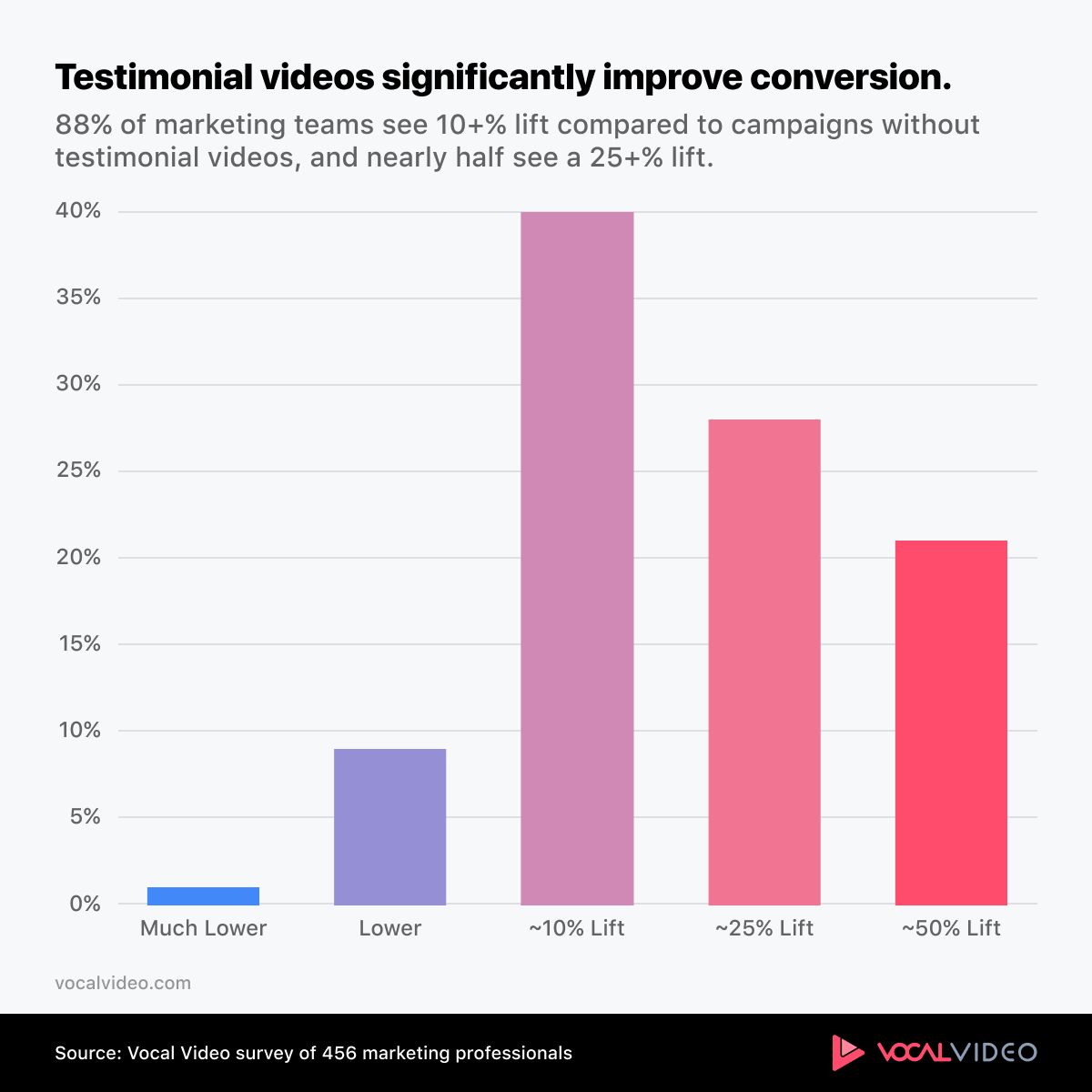
Read our in-depth article on the impact of testimonial videos on digital marketing.
Typically though, customer testimonial videos have been seen as expensive and time-consuming to produce, requiring videographers and professional video editors to achieve high quality results. This has meant that many businesses have shied away from collecting video testimonials because they don’t believe they have the budget or resources to get it right.
We created Vocal Video to solve these logistical headaches with creating videos the old-fashioned way and instead make it really easy and fast for marketers to collect and publish authentic, good looking customer testimonial videos.
Read our Vocal Video founding story here.
Our platform allows you to request testimonial videos from your happy customers and get them to record them asynchronously for you. You don’t need to set up a time, arrange a film crew, or take up your marketing team’s time with a long film shoot. Your customer simply records answers to a few questions you’ve set using their own device.
The resulting video goes through an automatic editing process to give it the essential professional polish it needs and can be immediately published across your marketing channels without any additional editing (more on this process below).
Here’s an example of a typical customer testimonial video recorded using Vocal Video:
Read our in-depth article on how to record and collect video reviews.
Vocal Video: Collect and Record Video Customer Testimonials Quickly and Effortlessly
We specifically designed Vocal Video’s video testimonial collection and recording process so that, even if you have no previous experience of creating videos, you can collect and record a customer testimonial with minimum hassle.
Below we give you a quick outline of how to use our platform to collect video testimonials from satisfied customers, but if you’d like a more detailed rundown, see our in-depth article: How to Record High-Quality Video Reviews
Using Vocal Video’s platform, marketers take just a few minutes to set up a video testimonial request and no more than 10 minutes for their satisfied customers to record a video testimonial.
Here's a brief breakdown:
- Build your “video collector”.
- Name your video collector and add a welcome video or written message (in our experience video messages get better response rates).
- Add an optional incentive. Vocal Video offers a free monthly prize drawing, or you can choose your own gift, discount or other incentive.
- Write between three and five questions you want customers to answer. Our ready-to-use customer testimonial templates include questions you can adapt to your requirements.
- Include your company logo, colors, and branding. Your branding is used in the video to make it fully yours and to be as professional as possible.
- Send your satisfied customers a link to record their video testimonial in their own time.
Click to read our article for inspiration on designing video testimonial questions.
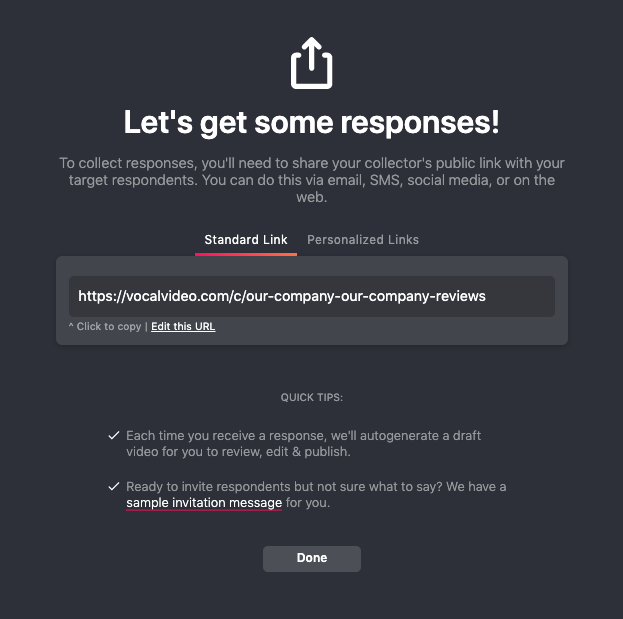
Click here to watch our 5-minute video with full details of how to build a video collector.
The video collector link you send out to request a video testimonial takes customers to your Vocal Video landing page. It’s fully branded with your logo and company colors so your customers never forget which brand is asking for a testimonial and always feel your company’s full involvement in the video collection process. On the landing page, customers answer each of the questions you added to the collector using the in-built camera on their computer, tablet, or smartphone.
After answering each question your customers can watch what they’ve recorded. From there, they can also choose to re-record their answer or click to submit if they are happy with it. After recording their answers to all the questions, they click to submit the video to you.
As we mentioned above, each testimonial video your customers record reaches you after going through an automatic editing process. This gives the video testimonials immediate polish and professional styling so you can use them exactly as you receive them.
The pre-editing process adds the following features to the video:
- Your brand colors and logo that you added in the video collector.
- Text overlays for attribution.
- Text slides for the video title, introductory message, questions asked, and a final CTA.
- Animated transitions between each video response.
- Automatically-generated captions and a transcript which make the video more accessible to a full range of users, and are also great for readability and SEO purposes.
- Royalty-free background music.
Although you can use these video customer testimonials immediately, Vocal Video also gives you the option to make your own changes using our in-built suites of video editing tools. You don’t need to use third-party tools, or hire a professional, to make extra edits and add more polish to the videos your customers send you.
Like the rest of the Vocal Video platform, our editing tools are designed for anyone to use. Even if you have absolutely no video editing experience it should take just a few minutes to master.
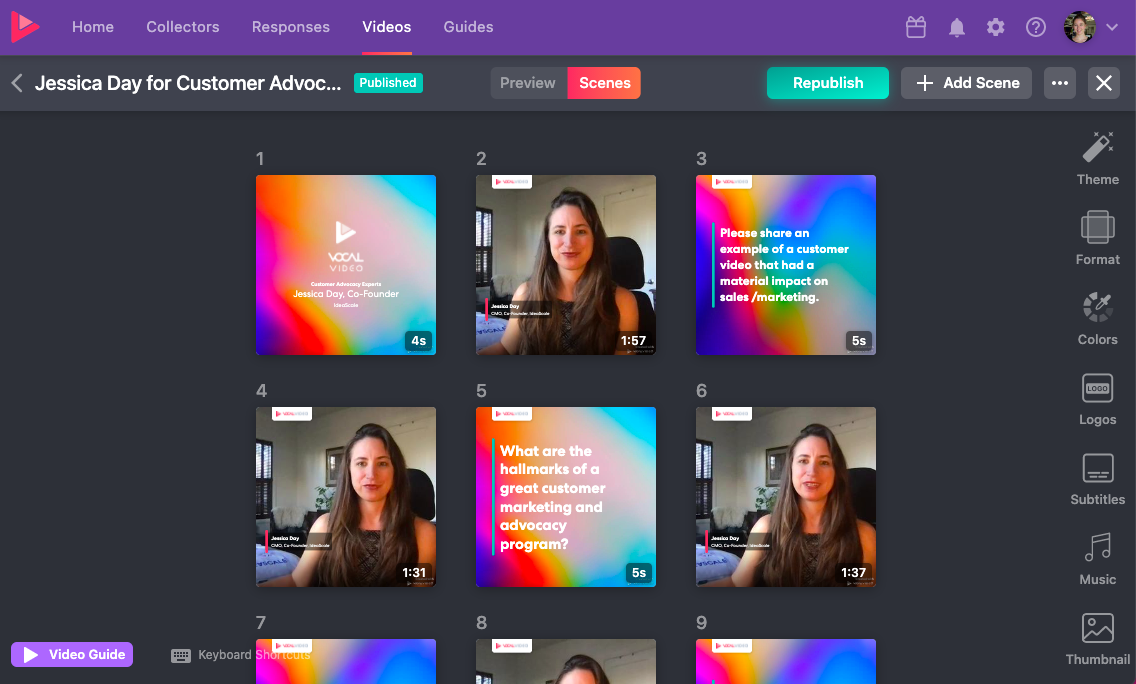
Using Vocal Video’s drag-and-drop editing tools you can:
- Trim scenes and edit down each of the responses.
- Change the order of each video response.
- Make changes to your colors, branding, and logos.
- Change the default background music.
- Edit and correct computer-generated captions.
- Modulate music and audio volume for easier listening.
For more information about how to edit your video testimonials within our platform, read: Testimonial Video Editing Made Easy: Create High-Quality Videos without Professional Expertise
Most Effective Ways to Use Testimonials in Your Marketing
Testimonials and reviews are some of the most influential content that you can show a buyer making a purchase decision. Once you’ve built your stockpile of testimonials, it is important that you fully leverage them throughout all your marketing communication activities to truly unlock the full value of social proof.
This social proof is applicable anywhere you are engaging your potential buyers. Reviews and testimonials are your best and most effective way to build trust with new buyers and ultimately boost your conversion rates - and who doesn’t want higher conversion rates?
Check out examples of real testimonial video examples from Google, Comscore, and Martha Stoumen Wines.
Mapping Testimonials to the Buyer’s Journey
Let’s return to the concept of the buyer’s journey. According to HubSpot, buyers go through three stages on their way to completing a purchase:
Awareness, Consideration, and Decision
 The Buyer's Journey - Hubspot
The Buyer's Journey - HubspotAs marketers, our job is to create relevant content for each stage of the journey so that a buyer can seamlessly move from awareness and education phases to consideration where he or she may be evaluating multiple solutions and ultimately to decision. We must map our content assets to each of these phases.
Testimonials and review content is an important component in this strategy. If you’ve built a rich stockpile of testimonials by asking specific questions to a diverse set of subjects, then you will have testimonials that speak to each phase of the buyer’s journey. For example, customer testimonials that speak to the problems your solution solves or expert testimonials from leaders in the domain are excellent content to leverage in the awareness phase of the buyer's journey. Likewise, testimonials and reviews highlight ROI and value propositions clearly map to consideration and decision stages.
Now, you must figure out creative and interesting ways to sprinkle these testimonials throughout your marketing. Below we've listed 7 great places to start.
You can also browse through 45 video testimonial templates we've put together, including example questions, email copy, and use cases. Each of these will either increase awareness and traffic to your site (top of funnel) or aid in converting more of the potential buyers that you have (bottom of funnel).
Social media posts and advertisements are excellent places to leverage testimonials and reviews. Social posts and ads should create immediate trust with a potential buyer and ultimately generate high qualified traffic that can be converted to leads and sales. A great testimonial, testimonial video, or even a review posted to the right hashtag or incorporated in an ad creative can be the centerpiece of a highly engaging, and effective ad or post.
Click here to check out some examples of great Facebook Ads with testimonials.

#2. Home Pages
Home pages are great places to display a select sample of your customer proof. A smattering of customer logos, a couple choice testimonials, or even an overall star rating of customer reviews are all proven techniques for boosting trust and getting buyers to explore further. The customer proof used on home pages ideally should be linked to deeper more in depth pages so buyers can go deeper and read more if they are so inclined.
For example, an overall star rating of customer reviews should link to a detailed wall of customer reviews where a buyer can peruse and read each individual review at his leisure.
#3: Customer Pages
A well done customer page or testimonials page should be the central hub of all your customer proof. You should aim to overwhelm a buyer with a rich and diverse display of customer love for your product and service. The best customer pages feature extensive customer videos and testimonials. Ideally if you have lots of videos and testimonials providing a way to sort, filter, and search your testimonials is advised.
As we’ve discussed, buyers tend to self-identify with customers who are like them (e.g. role or industry) so providing ways to view your testimonials and videos aids this process. Likewise, quantitative statistics on the customer base and the value that they have realized are also great elements to include on a customer page. This can be one of the most important pages for buyers to close the sale and convert.
#4: Exit Intent Pages
Exit-intent technology allows you to make one last-ditch effort to convert visitors as they are about to leave your site. By detecting when someone is about to navigate away, it presents the visitor with one final message (in a lightbox overlay) right at that pivotal moment.
This approach can be an effective way to capture emails. However, you need a compelling content offer and have built the requisite amount of trust. Displaying a choice testimonial or review as part of the exit intent message can help close the sale or capture an email for further nurturing.

#5: Checkout Pages
In eCommerce and SaaS, the checkout page is the ultimate "sell page". The buyer is on the one yard line and you want to put your best foot forward.
Growth marketers have run countless A/B experiments showing that customer proof can be highly effective on boosting conversion on this page. The best practice to include a testimonial, a choice review, or overall star review rating to allow the buyer to proceed with confidence.
#6: Landing Pages
In a similar vein to checkout pages, landing pages represent another key conversion point in the buyer’s journey. Buyers who happen on a landing page after clicking an email link, advertisement, or social media post are coming to your site cold. You need to convince them in a hurry to trust you and provide contact information for your offer. Testimonials represent an effective way to bridge the trust gap and get buyers to move to the next level in the buyer’s journey.
#7: Sidebars and Blog Pages
An often overlooked place to include testimonials is the sidebar of your website or blog. A testimonial whose message reinforces and is synchronized to the overall content topic is a strong social proof signal. The content will be more credible if 3rd parties, like customers, are ratifying the overall message. This can be a powerful trust marker.
Objectives:
- Take inventory of your web presence and buyer’s journey to identify the top places to embed and use customer testimonials
Key Results:
Takeaway
Testimonials and reviews are powerful stuff. They attract more visitors to your site and they convert more prospective buyers into paying customers. As a result, companies that make their customers the focus of their marketing perform better and are more trusted than other brands.
- They aren’t a gimmick. Creating and using customer testimonials regularly can be one of the few durable advantages that marketers like us have.
- If you aren’t using social proof in your marketing, start with the simple steps outlined in this guide, and don’t be overwhelmed with getting to perfection on day one. If you have an ad hoc program, it’s time to start gearing up for a way to make your efforts programmatic to see the maximum ROI. We hope that by reading this guide, we have armed you with new ideas, insights, and strategies to take your testimonial and social proof marketing to the next level.
Try Vocal Video free — no credit card required — and get started easily collecting, editing, and publishing customer testimonial videos and video reviews.